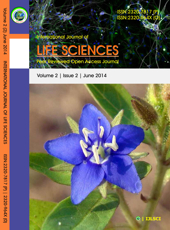Phytochemical assessment of five wild edible fruits
Keywords:
Antioxidants, Phytochemicals, Wild edible fruitsAbstract
Fruits are important ingredients in the human diets. Due to their high nutritive value, they make significant nutritional contribution to human well-being. The perishable fruits are available as seasonal surpluses during certain parts of the year in different regions and are wasted in large quantities due to unawareness, know-low for proper handling, distribution, marketing and storage. To create awareness regarding nutritive and medicinal values from these fruits, present investigation was carried out. The selected wild edible fruits were (Ficus racemosa, Elaegnus conferta, Antidesma ghasembilla, Grewia tillifolia and Scleichera oleosa) in their mature and ripen stage.. Various parameters were carried out like moisture, dry matter, carotenoids, carbohydrate (reducing sugar, starch, soluble sugar) antioxidant enzymes like catalase, peroxidase, superoxide dismutase. All five wild edible fruits were rich in vitamins, proteins and in antioxidant enzymes. The nutritional and phytochemical composition of fruits indicates that, these neglected wild edible fruits can be a valuable source of nutrients under famine conditions and high levels of some vitamins, antioxidants and can be used to prevent diseases.
Downloads
References
1. Aberoumand A, Deokule SS (2009) Determination of Elements Profile of Some Wild Edible Plants. Food Anal. Methods, 2: 116-119.
2. Abu-Goukh AA, Abu-Sarra AF(1993) Compositional changes during mango fruit ripening. University of Khartoum. J. Agric. Sci., 1(1): 33-51.
3. Acharya, K. P. and Acharya, R. (1957) Eating from the wild: indigenous knowledge on wild edible plants in parroha vdc of rupandehi district, central Nepal. Int. J. Social Forestry, 3(1): 28-48
4. AOAC, (1990): Official Methods of Analysis. Association of Official Analytical Chemists, Washington. DC.
5. Cekin C and Ozgen M (2010) Comparision of antioxidant capacity and phytochemical properties of wild and cultivated red raspberries (Rubus idaeus L.). J. Food Compo. Analysis, 23: 540-544.
6. Cho SI, Wai WK, Krutz GW, Stroshine RL (1993) Prototype of non-destructive fruit sweetness sensor, Horticult. Abstracts, 63(1): 69.
7. Desai N, Gaikwad DK, Chavan PD(2010) Proximate composition and some physicochemical properties of morinda pulp. Int. J. Applied Bio. Pharma. Tech., I (2):679-682.
8. Day RA, Underwood AL (1986) Quantitative analysis. 5th ed.Prentice-Hall publication, 701.
9. Effiong GS, Bia TO, Udofia US (2009) Nutritive and energy values of some wild fruit spices in southern nigerian. Electronic J. Envi. Agric. and Food Chem., 8(10):917-923.
10. Folin O, Denis W (1915) A colorimetric estimation of phenols (and phenolic derivatives) in urine. J. Biol. Chem., 22: 305-308.
11. Gouado I, Aba ER, Some IT, Florine JS and Tchouanguep MF (2007)Carotenoid content of some locally consumed fruits and yams in Cameroon. Pak. J. Nutr., 6: 497-501.
12. Hawk PB, Oser BL, Summerson WH (1948) Practical physiological chemistry (Publ.). The Blockiston Co. USA.
13. Hind AB, Abu-Baker A, Abu-Goukh A (2003) Compositional changes during guava fruit ripening. Food Chem., 80: 557-563.
14. Heber (2009) Energy-enhancing antioxidant:Natural Factors Nutritional Products Ltd.:1-2
15. Huang R, Xia R, Hu L, Lu Y, Wang M (2007) Antioxidant activity and oxygen-scavenging system in orange pulp during fruit ripening and maturation. Scientia Horticult., 113: 166–172
16. Kirk JO, Allen, RL (1965) Dependance of chloroplast pigment on actidione Arch. Biochem. Biophys. Res. Commun., 21: 523-530.
17. Larsson M, Rossande-Hulthen L, Sandstome B, Sandberg A (1996) Impoved iron and zinc absorption from breakfast meals containing malted oats with reduced phytate content. Btriti. J. Nutr., 76: 677-688.
18. Liener IE, Kkade ML (1980) Protease inhibitor. In Liener, I. E. (ed).Toxic constituents of plants foodstuffs. Academic Press. New York.
19. Malla SB, Rajbhandari SB, Shrestha TB, Adhikari PM, Adhikari SR (1982) Wild edible plants of Nepal. Dept Med. Pl. Bulletin No.9. Kathmandu.
20. Maehly AC (1954) Methods in biochemical analysis (Ed.) Glick D. (Publ.) Interscience publishers Inc. New York: 385-386.
21. Manandhar NP (1991) Some additional note on wild food plants of Nepal. J. Nat. Hist. Museum, 12: 19-32.
22. Nkafamiya II, Modibbo UU, Manji, AJ, Haggai D (2007) Nutrient content of seeds of some wild plants. African J. Biotech., 6 (14): 1665-1669.
23. Nelson N (1944) A Photochemical adaptation of the Somogyi method for the determination of glucose. J. Biol. Chem., 153: 375-380.
24. Niranjana P,Gopalakrishna KPR, Sudhakar DVR, Madhusudhan (2009) Effect of pre-cooling and heat treatment on antioxidant enzymes profile of mango and banana. African Journal of Food, Agriculture, Nutrition and Development, 1-12.
25. Reddy MB, Love M (1999)The impacts of food processing on the nutritional quality of vitamins and minerals. Adv. Exp. Med. Bio., 459: 99-106.
26. Rahman AK, Huq E, Mian AJ, Chesso A (1995) Microscopic and chemical changes occurring during the ripening of two forms of jackfruit Artocarpus heterophyllus L. 52(4): 405-410.
27. Subramanyam H, Gouri S, Krishnamarthy S (1976) Ripening behaviour of mango fruit graded on specific gravity basis. J. Food Sci. Tech., 13(2): 84–86.
28. Vidrin R, Ulrih NP, Zlatic E, Hribar J, Prgomet Z (2008) The nutritional and physico-chemical properties of ripe (Ziziphus jujube) fruits grown in Istria. International Jujube Symposium. ISHS Acta Horticulturae: 840.
29. Whiting GC (1970) Sugars. In: Hulme AC (Ed.), The Biochemistry of Fruits and Their Products. Academic Press, London: 1–31.
Downloads
Published
How to Cite
Issue
Section
License
Copyright (c) 2014 Authors

This work is licensed under a Creative Commons Attribution-NonCommercial-NoDerivatives 4.0 International License.
Open Access This article is licensed under a Creative Commons Attribution 4.0 International License, which permits use, sharing, adaptation, distribution and reproduction in any medium or format, as long as you give appropriate credit to the original author(s) and the source, provide a link to the Creative Commons license, and indicate if changes were made. The images or other third party material in this article are included in the article’s Creative Commons license unless indicated otherwise in a credit line to the material. If the material is not included in the article’s Creative Commons license and your intended use is not permitted by statutory regulation or exceeds the permitted use, you will need to obtain permission directly from the copyright holder. To view a copy of this license, visit http://creativecommons.org/ licenses/by/4.0/











